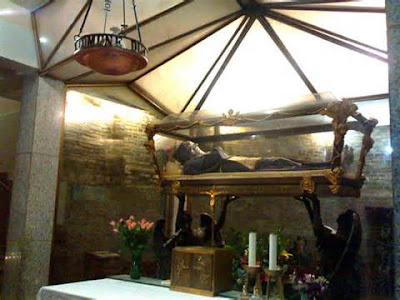My
mother is very patient, especially with tedious tasks. When I was a
girl, definitely less than 12 years old, I went to my mother one day
with a big, tangled mess of yarn. I asked her would she please
untangle it. I was lucky that she had nothing more important to do at
that moment, so she patiently started to untangle the mess with her
strong, long well-manicured nails. (Unfortunately, I did not inherit
these). She patiently continued the untangling, and after about 30
minutes, had undone all the knots, and had wound the yarn into a
fairly large, neat ball.
A
few years ago, I needed to pray about a very difficult situation.
Somehow I stumbled upon the devotion to Our Lady, Undoer of Knots.
There was a novena for this.
As
I prayed the first day of the novena, I remembered my mother and the
tangle of yarn, and her great patience in its gradual transformation
into a neat ball. It seemed that the Blessed Mother was quickly
making progress with the knots in my life. On the second day of the
novena, and again on the third, important events occurred to help
begin the process of problem-solving. It's taken a few years to get
to this point, where things are substantially better.
“The
Marian devotion entitled Mary Untier of Knots shares its name with a
[400] year old painting depicting Our Lady untying the knots of a
white wedding ribbon. This painting played a significant role in the
history of Mary Undoer of Knots Devotion. A German nobleman,
Wolfgang Langenmantel was distressed when he found his wife Sophia
was planning to divorce him.
To
save his marriage, Wolfgang sought counsel from the wise and pious
Fr. Jakob Rem. Fr. Rem, a Jesuit priest, was known to have a strong
devotion to Mary. Dedicated to his marriage Wolfgang brought Sophia
to meet with Fr. Rem 4 times in 28 days. On their fourth visit on
September 28, 1615, the Langenmantel’s brought their wedding
ribbon. In this time period it was customary for the maid of honor to
tie together the arms of the bride and groom. This uniting of arms
with a ribbon symbolized their union for life.
Before
an image of Our Lady of Snows, Fr. Rem took the white ribbon and
untied the knots one by one. When he finished the ribbon became
dazzling white. This was taken as confirmation that Mary had heard
their prayers. Fortunately, the divorce was averted, and the
Langenmatels remained happily married.”
Many
years later, the couple's grandson donated a family altar, and he
commissioned Johann Schmittdner to do a painting for it, and
inspired by the story of the ribbon, he painted the Baroque painting
‘Mary Untier of Knots.’
“The
painting has survived wars and revolutions, and continues to draw
people to it. Today the original still hangs over the family altar
found at the Church of St. Peter am Perlach in Augsburg, Bavaria,
Germany.”
For
some more information about the symbolism in the painting, see here.
Our
Lady, Undoer of Knots, pray for us.
If you want to see all of the posts in this series, click HERE.
Louise LaMotte is a friend from Light on Dark Water. Since she lived in Australia at the time we met online, I never thought we would meet in person. I was wrong. She has written here about St. Mary of the Cross, Pope St. Pius X, Fr. Jacques Hamel, and St. Damien of Molokai.
If you want to see all of the posts in this series, click HERE.





